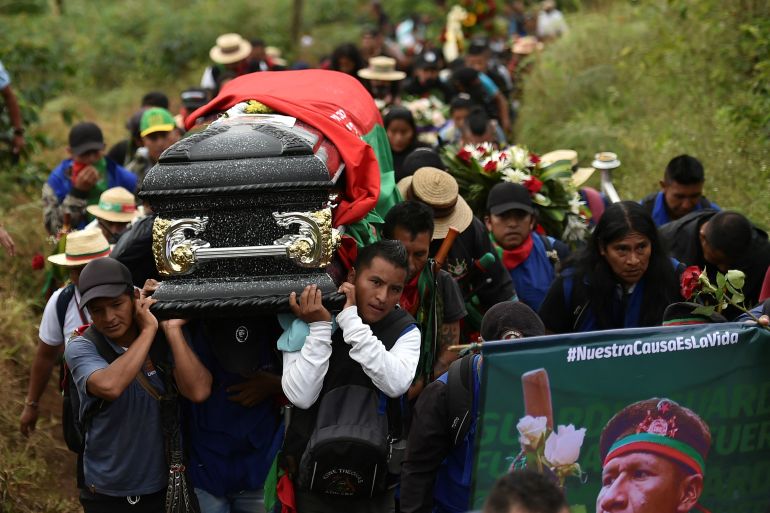Colombia’s Indigenous population faces scourge of violence
In 2021, an Indigenous person in Colombia was killed every four days, according to a new report.

Bogota, Colombia – Late last month, 25-year-old Indigenous leader Yermy Chocue was found dead near her home in Morales, in the Colombian department of Cauca. The young woman, a prominent human rights defender, had reportedly been approached and shot by armed men.
“Yermy’s dreams and hopes were thwarted by the violence that is consuming the country,” the Regional Indigenous Council of Cauca said in a statement.
Keep reading
list of 3 items‘Hidden genocide’: Death of Indigenous man in Brazil spurs outcry
Will Gustavo Petro live up to his promises to Colombia’s women?
Council member Mauricio Capaz told Al Jazeera that Colombia’s Indigenous communities were increasingly being “threatened and persecuted” in the years since the country’s 2016 peace accord, noting: “Indigenous peoples are going through a very complex situation. It’s almost six years of ongoing assassinations of Indigenous leaders.”
In 2021, a member of Colombia’s Indigenous population was killed every four days, according to a report released last month by the National Commission of Indigenous Territories (CNTI). The commission registered 114 homicides last year, 17 of which occurred in the context of seven massacres. Around a third of the victims were community leaders, and in approximately two-thirds of the cases, the perpetrator was not identified.
Overall, homicides in Colombia reached a seven-year high in 2021, with more than 13,000 registered.
“Indigenous communities have suffered disproportionately from targeted violence, displacement and massacres throughout Colombia’s conflict, particularly in the years since the peace accord,” Elizabeth Dickinson, a senior Colombia analyst with the International Crisis Group, told Al Jazeera.
Analysts say a power vacuum generated by the mismanaged implementation of the 2016 peace deal between the Colombian state and the Revolutionary Armed Forces of Colombia (FARC) rebel group has fuelled the violence. The CNTI has documented a particular threat to the Nasa and Awa communities, who have together comprised about two-thirds of the victims. Capaz, himself a Nasa leader, said they have been targeted because “we have a long history of fighting against those we believe that are doing us harm”.
In an interview with Al Jazeera, Colombian Ombudsman Carlos Camargo acknowledged that the ongoing violence has “deepened the [Indigenous population’s] structural conditions of marginality”, adding: “The inequalities are due to a historical process of structural discrimination and racism that has not yet been overcome, which in turn has created a gap distancing Indigenous peoples from their individual and collective rights.”
Government neglect
The CNTI report comes at a turbulent time for the country’s Indigenous population, as protesters and police clashed in Bogota earlier in October, resulting in at least two dozen injuries. Observers say the government’s neglect of Indigenous communities has been a key factor in the worsening state of affairs.
“There is no state presence, so that enables other actors to take over governance,” Camilo Nino, an Arawak leader and technical secretary of the CNTI, told Al Jazeera. “We believed that when the peace accord was signed, peace would come to our territories – but what we’ve seen instead is that the violation of human rights has been exacerbated since the agreement.”
According to Dickinson, this problem has been compounded by political disenfranchisement among Indigenous communities: “The state is not as inclined to respond to their situation in the way that they might to a high-powered business community or an important political constituency, so that contributes to the violence, and it renders the state complicit in many ways.”
Colombia’s interior ministry did not respond to Al Jazeera’s multiple requests for comment on the matter.
The threat to Indigenous communities has been exacerbated by the strong presence of armed groups and illicit economies, with many Indigenous communities situated near territories that house prominent drug routes and resource-rich land used for mining, both legal and illegal.
“These powerful illegal economies establish themselves through violence, which is used to eliminate all the voices that stand up to them,” Capaz said.
Much of the violence is concentrated in the country’s southwest, especially Cauca, where 43 percent of the 2021 killings occurred. Dickinson said the Indigenous population in Cauca has been working especially hard in recent years to resist the takeover of their land by armed groups. “As a result, the same armed groups who want to take over those areas and carve up trafficking routes and other illicit economies retaliate against Indigenous authorities who reject their presence,” she said.
More than a third of the Indigenous victims last year were between the ages of 18 and 32, the CNTI found – a concerning trend that reflects the targeting of a new generation of political leaders.
The violence presents a significant obstacle for President Gustavo Petro’s promise of “total peace”, a process set to include negotiations with armed groups.
“The issue of peace and saving lives is not an issue of party politics; it’s an issue that should interest us all,” Indigenous congressman Ermes Pete told Al Jazeera. “In four years, it will be very difficult [to solve], but the idea is that we make a great deal of progress.”
Capaz acknowledged the journey would not be easy, “but we cannot lose hope”, he added. “The Indigenous movement has never stopped fighting.”